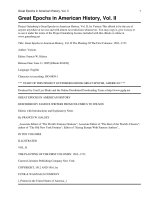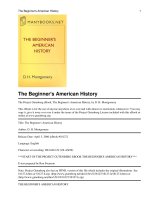african american history
Bạn đang xem bản rút gọn của tài liệu. Xem và tải ngay bản đầy đủ của tài liệu tại đây (8.05 MB, 259 trang )
A KID’S GUIDE TO
AFRICAN
AMERICAN
HISTORY
MORE THAN 70 ACTIVITIES
ISBN-13: 978-1-55652-653-4
ISBN-10: 1-55652-653-9
$14.95 (CAN $18.95)
AGES 6–11
A Kid’s Guide to African American History SANDERS
$14.95 (CAN $18.95)
H
ere are more than 70 hands-on activities, songs, and
games that teach kids about the people, experiences, and
events that shaped African American history.
❂ Make peanut butter like George Washington Carver did
❂ Make a medallion like those worn by early abolitionists
❂ Write a Brer Rabbit story
❂ Play the rhyming game “Juba”
❂ Design an armband like the one worn by a black chief of
the Crow nation
❂ Make a washtub bass
❂ Wear a kufi for Kwanzaa
Along the way, kids will also learn about inspiring African American artists, inventors,
politicians, and heroes, including Harriet Tubman, Langston Hughes, Oprah Winfrey,
Louis Armstrong, Rosa Parks, Tony Gwynn, and Bessie Coleman.
“A fascinating look at an aspect of American history that is often left out of history
books.”
—Washington Sun
“With a straightforward, readable text . . . and simple illustrative drawings, even young children
can participate in this activity-based title.”
—School Library Journal
“Parents, teachers, and students can pick up this book and be proud of its content.
It not only teaches the mind, but also the heart of understanding.”
—Dorothea (Wilson) Clausen,
great-great-great-granddaughter
of Thomas Jefferson
NANCY I. SANDERS
AFRICAN
AMERICAN
HISTORY
MORE THAN 70 ACTIVITIES
NANCY I. SANDERS
Library of Congress Cataloging-in-Publication Data
Sanders, Nancy I.
A Kid’s guide to African American history / Nancy I. Sanders. — 2nd ed.
p. cm.
Includes bibliographical references and index.
ISBN-13: 978-1-55652-653-4
ISBN-10: 1-55652-653-9
1. African Americans—History—Juvenile literature. 2. African Americans—
History—Study and teaching—Activity programs—Juvenile literature. I. Title.
E185.S19 2007
973’.0496073—dc22
2006031670
Cover and interior illustrations and design: Rattray Design
The author and the publisher disclaim all liability for use of the information
contained in this book.
The author has made every effort to secure permissions for all the material
quoted in this book. If any acknowledgment has inadvertently been omitted,
please contact the publisher.
©2007 by Nancy I. Sanders
All rights reserved
Second edition
Published by Chicago Review Press, Incorporated
814 North Franklin Street
Chicago, Illinois 60610
ISBN-13: 978-1-55652-653-4
ISBN-10: 1-55652-653-9
Printed in the United States of America
54321
To all my friends at Sisters in Christ Bible
Study. Your prayers, encouragement, and
support helped make this dream a reality.
To Rosa Parks.
Little did I know, when I saw you speak,
of the impact your life would have on me.
To Bessie Jones,
who inspired me as I read about her life.
May her memories and heritage live on
for generations to come.
‚ Contents ¯
Time Line vi
Acknowledgments viii
Introduction ix
1 ∏ THE GLORIES OF AFRICA
A Sandstone Column 3
Design a Mask 4
The Middle Ages 7
The City of Timbuktu 7
Potato Stamp Painting 9
A King’s Scepter 11
Life in Africa 12
Call-and-Response Game 13
Communities and Nations 14
2 ∏ COLONIAL AMERICA
Early Explorers 16
First Settlers 18
Landing in Jamestown 19
The Beginning of Slavery 21
Fort Mose 23
The Slave Trade 24
Bead Necklace 26
The Middle Passage 27
Landing in America 29
The Revolutionary War 29
The Shot Heard Around the World 30
Merchant Ships 33
The Battle of Bunker Hill 37
Black Patriots in the American Revolution 38
The War at the Sea 40
The Free African Society 42
The Forten Family of Philadelphia 43
Play a Game of Marbles 44
Write an Almanac 48
Make a Star-Watching Chart 50
America’s Founding Fathers 52
Founding Fathers in Philadelphia 53
Founding Fathers in Boston 56
Kneeling Slave Medallion 59
A Foundation of Faith 61
3 ∏ LIFE ON A PLANTATION
Food on a Plantation 66
Juba 69
Brer Rabbit and His Friends 70
Tell Me a Riddle 74
Children’s Rhymes 75
Children’s Songs 76
Children’s Games 78
Sew a Doll 82
Hoop and Stick 84
Artistic Crafts 85
Music and Rhythm 85
Make a Rhythm 87
Jingle a Tambourine 89
Build a Washtub Bass 92
Short’nin’ Bread 94
The Blue-Tail Fly 94
O Freedom 96
Uncode a Spiritual 97
4 ∏ FREE AFRICAN AMERICANS AND
ABOLITIONISTS
The American Colonization Society 102
Emancipation Papers 105
Fugitive Slave Laws 106
The Black Press 107
Slave Narratives 110
Giants in Literature 111
Election Day 113
Parmenteering 114
Election Day Parade 115
Election Cakes 117
Pinkster Day 118
Dress Like King Charles 119
Wear a Chain of Blummies 123
Dance on a Shingle 125
Hold a High Jump Contest 126
The Quakers and Other Abolitionists 127
The Underground Railroad 127
Carry a Candle 130
Carry a Stick 132
Follow the North Star 133
Native American Communities 134
Make a Native American Apron 136
Wear Cuffs 138
Wear Armbands 140
Craftsmen and Folk Artists 141
Make a Bible Quilt 143
5 ∏ CIVIL WAR AND THE ROAD TO
FREEDOM
Make a Congressional Medal of Honor 148
Make Paper Doll Replicas of the U.S. Colored Troops 150
Emancipation Day 154
Reconstruction 154
Elected Officials 156
Hold an Egg-Cracking Party 157
Have a Taffy Pull 159
Sharecropping 160
The Exodusters 160
Juneteenth 162
Make a Favorite Drink 164
Cowboys 165
Design a Brand 167
How Far Was a Trail Ride? 169
Buffalo Soldiers 171
Jim Crow 171
The Tuskegee Institute 173
Make Peanut Butter 174
Grow a Sweet Potato Vine 176
Conduct a Scientific Experiment 177
6 ∏ THE TURN OF THE CENTURY
Great Achievements 180
Important Inventions 181
Make Your Own Invention and Patent It 183
The Importance of Music 185
Harlem Renaissance 186
Play the Cornet 190
The World at War . . . Twice 191
Creative Milestones 193
Sports, America’s Favorite Games 195
Track-and-Field Day 196
7 ∏ THE CIVIL RIGHTS MOVEMENT
How One Woman Made a Difference 202
Segregation in Schools 202
Carry a Card Supporting Nonviolence 204
The Sit-In Movement and Freedom Rides 206
Children Helped Change a Nation 207
Make a Hand Fan 210
The March on Washington 212
Carry a Sign 213
8 ∏ HOPE FOR TODAY AND A BETTER
TOMORROW
Dedicated Historians 216
A New African American Renaissance 217
All-Star Athletes 221
Kwanzaa 226
Celebrate Kwanzaa 230
Wear a Kufi 233
Joining Together for a Future of Hope 234
Suggested Reading List for Kids 235
Teacher Resources 235
Selected Bibliography 236
Index 241
‚ Time Line ¯
The Glories of Africa
*3100 B.C. Menes, the first pharaoh of united Egypt begins his reign
*1379 B.C. Nefertiti, Queen of Egypt, begins her co-rule of Egypt
*A.D. 1500 Timbuktu, one of the greatest cities of the world is established
1527 Estavanico explores the American Southwest
Colonial America
1619 Twenty Africans land at Jamestown, Virginia
1641 Slavery is legally recognized in the colonies
1770 Crispus Attucks is the first to die in the American Revolution
1807 Congress bans ships from bringing slaves to America
1843 Sojourner Truth speaks out against slavery
Abolitionists
1849 Harriet Tubman escapes from slavery and begins work on the
Underground Railroad
*Approximate date
Civil War
1861 Civil War begins
1863 President Lincoln signs the Emancipation Proclamation
1865 Thirteenth Amendment ends slavery in America
Freedom’s Road
1881 Booker T. Washington establishes the Tuskegee Institute
1903 W. E. B. Du Bois publishes The Souls of Black Folk
1909 National Association for the Advancement of Colored People
(NAACP) is founded
1920s The Harlem Renaissance, a time when extraordinary works are
created by musicians, artists, and writers, reaches its peak
1936 Jesse Owens wins four Olympic gold medals
Civil Rights Movement
1955 Rosa Parks is arrested
1961 Freedom Rides take place
1963 The March on Washington is held
A New Hope
1966 The first celebration of Kwanzaa is held
1967 Thurgood Marshall is appointed as a Supreme Court justice
1976 Black History Month is established
1986 National holiday is created to honor Dr. King
viii
T
hank you, Jeff, for your enthusiasm for this
book. I appreciate the many times you
alert me to current events in the news to
help keep this information up-to-date. And
thanks, Danny and Ben, for your continued enthu-
siasm and interest in my writing projects. You guys
are the best!
Thank you, Evelyn Okoreeh, my dear, sweet
friend. Your prayers and encouragement sustain me.
A special thank you goes to all the historians
whose intense research and accurate facts help
make it possible for me to share African American
history with kids. Your books line my bookshelves
and are friendly faces that greet me each day I sit
down in my office to write. Among the many histo-
rians whose outstanding work I constantly refer to,
I would especially like to express my appreciation
to Carter Woodson, Charles W. Wesley, Benjamin
Quarles, Lerone Bennett Jr., Darlene Clark Hine,
Jessie Carney Smith, and Henry Louis Gates Jr.
Without the enthusiasm of certain individuals
who have helped me gather important research,
writing this edition would have been more difficult.
I would especially like to thank Deborah Padgett
from the Jamestown-Yorktown Foundation, Susan
Halpert from the Houghton Library, and Sheila
Cooke-Kayser, Emily G. Prigot, and Dr. Martin
Blatt of the Boston National Historical Park.
Thanks to the entire publishing family at
Chicago Review Press. It takes a team to bring a
book to life, and you all are appreciated for the
countless hours of creative energy you devoted to
this project. Thank you, Cynthia Sherry, for your
continued vision of this project. And thank you,
Michelle Schoob, for stepping up to the editorial
plate to help make this second edition a winner.
‚ Acknowledgments ¯
Y
ou probably learned that Columbus
explored America in 1492, but did you
know that when Columbus landed in
America, he heard stories of courageous blacks who
had already arrived before him from across the
ocean to trade gold with the Native Americans?
You’ve learned how the Pilgrims landed at Ply-
mouth Rock. But did you know that before the
Mayflower ever set sail, there were already African
Americans living in Jamestown, V
ir
ginia? And
when you reach for the light switch, you might
remember Thomas Edison, but did you know that
Lewis H. Latimer, an African American, invented a
way to make a lightbulb last even longer?
When people used to write history books, they
often skipped over important things done by
African Americans. But today, researchers show us
that African Americans have made amazing discov-
eries and outstanding accomplishments. Through
hard work, intelligence, faith, and determination,
African Americans helped build the strong nation
of America and are still impacting the world today.
The history of African Americans is a story that
is both triumphant and sad. Through the many suf-
ferings of slavery and discrimination emerged indi-
viduals and eventually a group of people who have
made a difference in the lives of others.
Come along and join in the adventures you’ll
discover in this book. Participate in the historically
based activities. Carve a miniature sandstone col-
umn similar to the one found in the ruins of a
beautiful Ethiopian temple. Make a medallion just
like the famous one that was used to persuade peo-
ple to stop slavery. Tell a Brer Rabbit story echoing
the ones told in the South. Design a brand similar
to the ones black cowboys used on cattle in the
ix
‚ Introduction ¯
West. Learn about nonviolent protests, just like
students during the Civil Rights Movement. Cele-
brate Kwanzaa and honor the history and pride of
an extraordinary group of people. As you do all
these things, and more, the story and the heritage
of African Americans will come to life.
x
What’s in a Name?
T
his book is the history of a group of people stolen
away from their home and forced to work as slaves
in an unknown land. Having lost everything, these people
sought to restore their heritage, even through the identifica-
tion of a specific name. Today they are proudly known as
African Americans.
Here is a brief history of how the term
African Ameri-
can
came to be used.
∏ In 1619, when a group of indentured servants landed in
Jamestown, Virginia, John Rolfe wrote in his diary, “A
Dutch ship sold us 20 Negars.”
∏ Slaves were often referred to as
Africans
, which identi-
fied them with their roots.
∏
During the 1800s, slave workers in a plantation house
began calling themselves
colored
to show they were dif-
ferent from the workers in the field. Many had both
black and white parents or grandparents.
∏
From the 1830s to the 1860s, many people didn’t want to
be called
African
anymore. Most of their families now
lived in America.
∏
In 1890, Booker T. Washington encouraged the use of the
word
Negro
to bring unity.
∏
In the 1960s, the term
black
gained respect through the
Civil Rights Movement.
∏
Today, the term
African American
identifies this group of
people with a homeland as well as the important history
and culture they have developed in the United States.
Any titles or terms used in this book are not used to offend anyone, but as
a reflection of the era being discussed.
H
istory is often silent about many things
that happened long, long ago. Nobody is
living today who can
give us firsthand accounts of
events many years before we were
born. But we have clues that help
us discover important things about
the past. Special scientists called
archaeologists (say it: ark-ee-ALL-
uh-gists) use these clues to help us
understand what Africa was like hun-
dreds of years ago.
There are pictures on the tombs of
Egyptian pharaohs (say it: FAIR-ohs)
showing dark-skinned rulers as well as light-
1
skinned ones. Queen Nefertari (say it: nef-fer-
TAR-ee), one of the most famous figures known
today from Egypt, has been identi-
fied as black. There are ancient
documents listing important victo-
ries and accomplishments by kings
from African countries. Stories have
been passed down from generation to
generation describing the glories and
wonders that used to exist. All these
clues, and more, paint a picture to help
us understand what ancient Africa was
really like.
Prior to 800
B.C., the dark-skinned peo-
ple from Ethiopia (say it: EE-thee-OH-pee-ah)
1
The Glories of Africa
in Africa had important contact with ancient
Egypt. They traded goods and materials back and
forth. They fought wars with each other. They mar-
ried each other and had children.
The fact that the color of their skin was differ-
ent did not seem to matter very much to them.
For many years, Ethiopia had to pay taxes to
Egypt and was under Egypt’s rule. However, in the
eighth century
B.C., the Ethiopians went to war
against the Egyptians and won. For more than a
hundred years, the land was ruled by Ethiopian
pharaohs.
Around 400
B.C., people in Africa made impor-
tant progress and accomplished great achievements.
In the years known as the African metal age,
Africans worked with metals such as iron, copper,
tin, silver, and bronze. They built large cities where
crafters developed skills in leather, glass, gold, and
weaving. They planted many crops. A huge system
of trading developed. It was an age of progress and
excitement.
2
Menes
(lived around 3100 B.C.)
T
radition says that the African king Menes
(say it: mens) united Upper Egypt and
Lower Egypt into one strong kingdom. With this
union began the long line of pharaohs who ruled
Egypt for 3,000 years. During the time of Menes,
hieroglyphic writing developed. Technical skills,
arts, and governmental institutions were improved
during his rule.
3
S
ome of the Ethiopian rulers were known for
building beautiful temples and monuments.
A sandstone column still stands, carved
with many detailed designs, in the ruins of an
Ethiopian temple. With this activity, you can make
a replica.
Materials
Adult supervision required
1 cup (200 g) clean sand
1
⁄2 cup (60 g) cornstarch
1 teaspoon (5 g) cream of
tartar
Old cooking pot
A Sandstone Column
medium heat. Stir well until the mixture of sand is
too thick to stir any more. Cool slightly and then
spoon the mixture into a cup, tightly packing down
the sand. Turn the cup upside down over a paper
plate and let the sand mixture dump out to form a
column on the plate. (You may need to squeeze the
end of the paper cup to get it started.) Smooth the
sides of the column with your hands. Use a tooth-
pick to carve designs in your sandstone column like
the one pictured here.
Wooden spoon
3
⁄4 cup (177 ml) hot
water
Paper drinking cup
Paper plate
Toothpicks
Dump the sand, cornstarch, and cream of tartar
into the old pot. Use the wooden spoon to stir the
mixture well. Add the hot water and cook over
A
frican sculpture is known for its variety of
styles, different designs, and great
strength portrayed in the characters.
Researchers have found African sculpture in many
forms, including masks.
Materials
Illustrations of mask
Typing paper
Pencil
Scissors
1 9 by 11-inch (48 by 28 cm) sheet of black
poster board
1 9 by 11-inch (48 by 28 cm) sheet of white
poster board
Glue
White cotton household string
Use the illustration of the mask as a guide to
trace the nose, eyes, and mouth onto typing paper.
Cut these out and use them as a pattern to cut the
pieces from black poster board. Cut the outline of
the face out of white poster board. Glue the nose,
eyes, and mouth to the face. Spread glue on the
area of the white poster board that isn’t covered by
the nose, eyes, or mouth. Carefully glue short
pieces of string in rows over the white poster board
to resemble the original, carved design of the mask.
Design a Mask
4
5
exact size of pattern pieces
6
The finished mask has the eyes, nose, and mouth made out of black poster
board glued onto the white poster board head.
Taharka
(lived around 690 B.C.)
T
aharka (say it: tah-HAR-kah) is known as the
most important of the Ethiopian pharaohs.
An outstanding leader, some people called him the
“Emperor of the World.” He ruled for about 25
years. During his reign, he brought many cultural
improvements to his empire. He built many tem-
ples. He encouraged trade between Egypt and
Ethiopia. He also led a group of explorers as far as
the Strait of Gibraltar.
7
The Middle Ages
Africa was rich in gold. Traders arrived from the
north with large groups, or caravans, of more than
12,000 camels at a time. The camels carried heavy
loads of salt, sugar, wheat, fruit, and fabric across
the dry Sahara Desert until they reached the king-
doms in West Africa of Ghana (say it: GAH-nah),
Mali (say it: MAH-lee), and Songhay. Why did the
traders travel so far and on such dangerous journeys
across the hot desert? What did the traders want?
They wanted the gold of Africa.
The kingdoms of Ghana, Mali, and Songhay
grew powerful and wealthy by trading their gold
and other products to the caravans from the north.
By the Middle Ages, they had developed banking
systems, school systems, and entire systems of law.
The kings of these kingdoms were unbelievably
rich. One ruler of Ghana lived in a splendid castle
filled with sculpture and decorated with beautiful
windows. This ruler kept an army of 200,000 fight-
ing men. Soldiers in the armies of these rulers often
wore chain mail, a type of armor, and rode horses.
Troops carried impressive shields and armed them-
selves with swords and lances.
The City of Timbuktu
By the 15th century, the kingdom of Songhay dom-
inated the area with power. The city of Timbuktu
(say it: tim-buck-TOO) in Songhay became an
intellectual center where people traveled from far
away to experience its dazzling excitement and
study with its scholars.
During this time, Timbuktu was home to more
than 100,000 people. The towers of two important
mosques (say it: mosks) stood high above the other
buildings. Flat-roofed buildings spread out across
the city.
Moslem youths came to study law, math, and
medicine at the University of Sankore in Timbuktu.
Scholars came to Timbuktu to study its large collec-
tions of manuscripts, which included famous selec-
tions from Greek and Arabic literature. Scholars
came to write their own books, too. The trading of
books brought in more money than almost any other
kind of business. The kings paid judges, doctors, and
writers a large amount of money to do their jobs.
People enjoyed dancing, fencing, gymnastics, and
chess. Great respect was paid to learned people in
this intellectual center of West Africa.
8
Ghana
(1100)
Mali
(1300)
Songhay
(1475)
Egyptian Empire
(1400 B.C.)
Nile River
Niger River
Ethiopia
(1700)
Mediterranean Sea
Atlantic
Ocean
Gulf of Guinea
Madagascar
dates are approximate
Ghana
Mali
Songhay
Africa
9
Some artists painted Timbuktu during the Mid-
dle Ages to show a city made of square and round
buildings. In the center of the pictures, they
showed a tall mosque towering over the city. You
can make a stamp from a potato to paint a picture
of Timbuktu as it might have appeared during the
Middle Ages.
Materials
Adult supervision required
1 potato, uncooked
Table knife, not sharp
T
empera paint
Shallow tray or bowl
Construction paper
Cotton swab
Use the table knife to cut a potato in half. One half
of the potato will be used to stamp pictur
es of
square houses. Cut away the flat side of the potato
to form a raised square. Carve a small doorway in
the square. The other half will be used to stamp
pictures of round houses. Carve a small doorway
on the flat part of this potato.
Spread a shallow amount of paint in the tray.
Dip the potato halves in the paint, and paint a pic-
ture of Timbuktu by stamping round and square
buildings in rows across the construction paper. In
the center of the picture, paint a large building that
represents one of the great mosques in the city. Use
the cotton swab to paint the tall, thin tower at the
top of the mosque. This is how some artists have
painted Timbuktu during the Middle Ages.
Potato Stamp Painting
10
Picture of Timbuktu
Potato halves
I
n great cities such as Timbuktu, many people
were well educated and enjoyed a wealthy
lifestyle. Kings and rulers were among the
wealthiest of all. They dressed in splendid clothes,
wore beautiful jewelry, held fancy swords, and
sometimes carried scepters made of gold.
Materials
Adult supervision required
Scissors
2 paper bowls (plastic or Styrofoam
do not work as well)
2- or 3-foot (61 or 92-cm) long
cardboard tube from gift wrapping
paper
Glue
Styrofoam ball about 2 inches
(5 cm) in diameter
Gold acrylic craft paint
Paintbrush
Use the scissors to carefully cut a hole
in the bottom center of each bowl.
The holes should measure the same
size as the diameter of the cardboard
tube. Slide the two bowls, rims facing
each other
, onto one end of the card-
boar
d tube, about
1
⁄4-inch down from
the edge. Use a small amount of glue
to hold them in place. Glue the rims
of the bowls together. Allow to dry.
Glue the Styrofoam ball onto the cardboard tube,
just above the bowls. Paint the entire scepter gold.
A King’s Scepter
11
Life in Africa
The Continent
Africa is a vast land with a variety of climates—
jungles, deserts, rain forests, mountains, and lakes.
The Nile River flows in the northeast. The Congo
River crosses the equator twice. Grasslands are
found in the west. Animals such as elephants,
lions, and giraffes live there.
There were many wild and untamed areas in
ancient Africa, but research has shown us that
there were also many places of progress and culture.
In the Nile Valley, archaeological discoveries tell us
that Stone Age Africans made pottery and greatly
influenced the success of ancient Egypt. Classical
writers, such as Homer and Herodotus from Greece,
tell of the glorious empires found in northern and
central Africa. People traveled from far away to
come to Africa’s kingdoms, where elaborate net-
works of trade were built because of the abundance
of gold, silver, and salt.
Family Life
The family was very important. Often, family lines
of heritage were traced down through the mother,
known as a matrilineal (say it: mat-rih-LIN-ih-al)
line of descent. In many societies, a husband would
leave his own home and join the family of his wife
when they married. This was because in a matrilin-
eal society, all the wealth, property, and possessions
were passed on through the mother.
Family members who died were held in great
honor because death was considered the beginning
of a new life. Gifts were placed on graves to show
respect and love for the ancestors.
Faith meant a lot to each individual. Religion
was an important part of everyday life. Nature was
treated with great respect. People took special care
of natural resources such as water and trees.
12
13
M
usic was everywhere. Complicated and
beautiful dances were developed. Two
basic types of music could be found.
One used a variety of drums and percussion instru-
ments. The second type used a call-and-response
pattern where the song leader called out and then a
chorus of people responded, sounding like a chant.
Here is a children’s game you can play with your
friends. It’s based on the call-and-response pattern,
and it is still played in Africa today.
The song leader begins by asking, “What is big?”
The other children respond in a chanting chorus
saying, “Elephant is big.” As the song continues,
the song leader chooses other animals to ask about,
listing large animals such as a giraffe or rhinoceros.
(The song leader can repeat the names of animals
during the song.) The children chant back their
answer each time. However, if the song leader calls
out the name of a small animal such as a bird or a
mouse, children should not respond! Those who
accidentally respond are out of the game. The song
continues until there is only one player left in the
game. This player becomes the new song leader.
What Is Big?
Leader: What is big?
Chorus: Elephant is big.
Leader: What is big?
Chorus: Elephant is big
Among all the animals of the world.
There is none larger.
Call-and-Response Game









